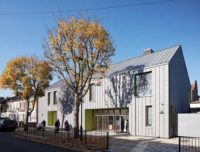Greenwich Housing by Bell Phillips Architects
London

The simple brick structure is topped by large, cowl-like windows clad in zinc that bring daylight deep into the rectangular units.
Photo © Edmund Sumner

The 22 units of 968 square feet apiece are spread out across six sites.
Photo © Edmund Sumner

A couple stands within the recessed entry of their unit.
Photo © Edmund Sumner

The one-story housing is located within the context of tall apartment buildings and small Victorian houses.
Photo © Edmund Sumner

A galley kitchen is sandwiched between the living and dining areas.
Photo © Edmund Sumner

The distinctive butterfly roof offers an intriguing fifth elevation.
Photo © Edmund Sumner

Image courtesy Bell Phillips Architects

Image courtesy Bell Phillips Architects








Architects & Firms
London
Bell Phillips Architects’ Greenwich Housing in South London provides 22 single-story homes for elderly and disabled people, and it is a hit with residents. They talk enthusiastically about the qualities of light and space, as well as things others might take for granted, such as their ability to get into a shower easily. But the public housing project’s greater significance comes from its wider context. While London is in the grip of a housing crisis, with soaring prices, rising demand, and supply constrained by development rules that limit outward and upward expansion, Greenwich Housing shows that architectural ingenuity can uncover latent opportunity for densification, at a reasonable cost.
The houses are arranged in short rows and split across six small publicly owned, underused parking lots. The topography of the sites varies—some are on hilly ground, others on flat—but all are irregularly shaped and hemmed in by neighbors ranging from modernist apartment blocks to petite Victorian row houses. Bell Phillips developed a standard house type that could be applied to each of these conditions, and to other sites later, with no alteration other than the color of the brickwork.
Single-story houses were demanded both by the program and by neighbors’ rights to light, but the architect was anxious to make a clear distinction between these urban dwellings and the folksy retirement bungalows that blight suburbia. “ ‘Bungalow’ is a loaded term,” says director Hari Phillips. “We wanted to make these houses cool rather than twee, and give them some prominence in the streetscape so they don’t seem shy about themselves.”
This has been achieved by the use of heavyweight brick facades and the manipulation of the butterfly roof form of each house, which comprises four mono-pitched sections of varying height, all falling to a central valley and clad in a taut skin of reddish-brown standing-seam zinc.
The front facade is a continuous band of masonry, with recessed porches marking individual entrances. It establishes a strong horizontal datum and gives each group of houses a collective presence greater than the sum of its parts. Above each entrance, the steepest mono-pitched roof section pops up to form a crisply folded zinc cowl, framing a deep-set window and adding height and variety to the roofline. Another roof section rises above the brickwork at the back, where each house has a small private garden. As all six sites are overlooked by surrounding buildings or from higher ground, the choppy sea of metallic peaks and troughs makes an intriguing fifth elevation.
In planning the 968-square-foot, two-bedroom houses, the architects were required to follow extensive guidelines covering the width and position of doors, wheelchair turning circles, and other accessibility concerns. They were also mindful that residents may spend extended periods at home and would benefit from a variety of spatial conditions, daylight levels, and views. Their first instinct was to emulate the efficiency of a single-story house built by Richard Rogers for his parents in 1969 (now a London outpost of Harvard’s GSD). There, bedrooms are entered directly off an open-plan living area, fully glazed at both ends. But contemporary fire regulations required that Bell Phillips insert a corridor between the kitchen and bedrooms; this potentially dead space is used to accommodate deep storage closets that are useful to downsizing residents.
The main bedroom overlooks the garden, while the second faces the front and might be used by guests or overnight caregivers, or as a hobby room. The open-plan living area comprises three distinct spaces. At the front, a dining room is brightly lit by the lantern window above the door, and the ceiling follows the sloping roofline to give an internal height rising to 11 feet. It adjoins a central galley kitchen, with a more intimate, low-ceilinged seating area beyond.
Each space reflects detailed consideration of the needs of older people. The architects decided against including an entrance lobby, which would retain heat when the door is opened but might hinder residents with reduced mobility. Likewise, a tall window next to the door provides a generous view of the street, which might counter feelings of isolation. If residents prefer to close the draperies for privacy, good daylight is maintained by the high-level window.
The benefits of Bell Phillips’s careful work will be felt not just by residents, who now enjoy suitable accommodation, but also by the young families who move into the larger spaces they vacate, making better use of existing housing stock. And for those who fear that London’s housing crisis is insoluble, the project offers reassurance that conditions of scarcity create fertile ground for architectural creativity.
PeopleArchitect: Bell Phillips Architects — Tim Bell, director in charge; John Lineen, project architect Engineers: Richard Jackson (structural) General contractor: Newlyns Client: Royal Borough of Greenwich Size: 21,000 square feet Cost: $5.6 million Completion date: September 2015
|
ProductsBrick BEA Building Products Windows and Doors John Watson Doors Roof VM Zinc
|













